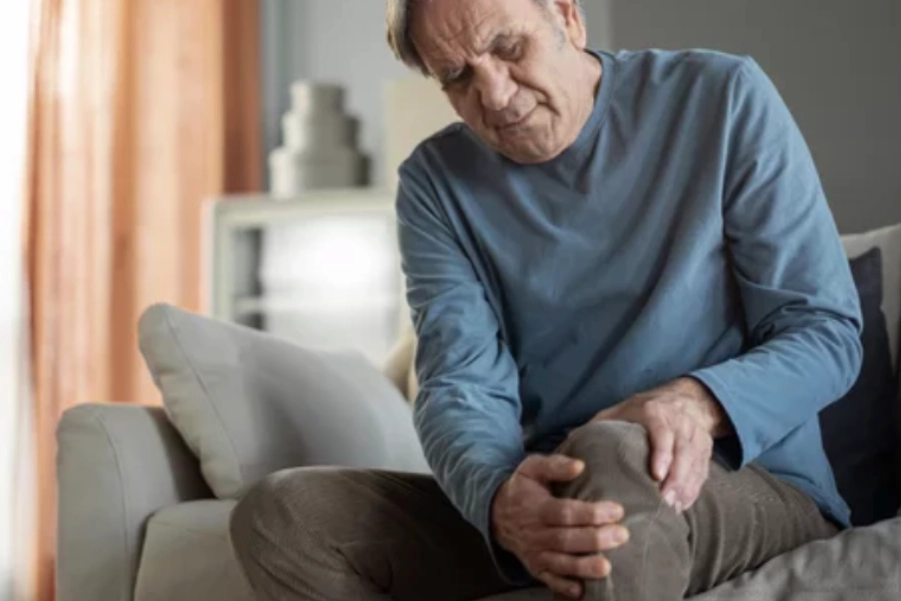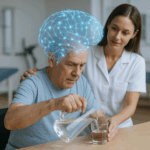Physiotherapy Treatment Protocol for Severe Osteoarthritis of the Knee
Overview of Conditions:
Severe knee osteoarthritis (OA) is characterized by advanced degeneration of the articular cartilage, significant narrowing of the joint space, osteophyte formation, and subchondral bone changes. This stage is marked by debilitating pain, significant functional limitations, and joint instability, often leading to an impaired ability to perform activities of daily living (ADLs) such as walking, climbing stairs, or standing for prolonged periods. The pain in severe OA may be present even at rest, and the knee joint may become visibly deformed or show significant swelling. Patients may experience substantial muscle weakness due to disuse, leading to further joint instability. In severe cases, conservative management, such as physiotherapy, may help reduce pain, improve mobility, and slow disease progression, but surgical intervention (e.g., total knee arthroplasty) may eventually be necessary if conservative measures fail.
Assessment and Evaluation:
History:
- The patient will report chronic, often severe pain, especially during weight-bearing activities.
- There may be significant functional impairment, such as an inability to walk for long periods or perform daily tasks.
- History of progressive symptoms over time, possibly worsened by trauma or repetitive stress.
Pain Assessment:
- Use Visual Analog Scale (VAS) or Numeric Pain Rating Scale (NPRS) to assess the intensity and quality of pain.
- Assess pain patterns: at rest, with activity, and after activity. Evaluate whether pain interferes with sleep.
Physical Examination:
- Postural Assessment: Look for signs of varus or valgus deformities (bow-legged or knock-knee), and altered gait patterns (e.g., limping).
- Range of Motion (ROM): Significant limitation in both flexion and extension, with possible crepitus on movement.
- Strength Testing: Weak quadriceps, hamstrings, and hip muscles contributing to decreased joint stability.
- Swelling/Joint Effusion: Considerable swelling or effusion in the knee joint, especially after weight-bearing activities.
- Special Tests:
- McMurray’s Test and Apley’s Test to rule out meniscal involvement.
- Varus/Valgus Stress Test to check for ligamentous instability.
- Patellar Apprehension Test if patellofemoral pain is suspected.
Goal Setting:
Short-Term Goals:
- Pain Management: Reduce pain intensity to a manageable level (VAS ≤ 3), particularly at rest and during minimal activity.
- Improve ROM: Increase knee ROM, with a focus on improving both flexion and extension.
- Swelling Control: Decrease knee swelling and promote lymphatic drainage after activity or periods of rest.
- Strengthening: Improve quadriceps, hamstrings, and hip muscle strength to enhance knee stability and reduce load on the joint.
Long-Term Goals:
- Enhance Functionality: Improve functional mobility for ADLs, such as walking, stair climbing, and standing.
- Joint Stability: Maintain or improve joint stability by strengthening supporting muscles around the knee.
- Delay Surgery: Improve the quality of life and delay the need for surgical intervention (e.g., total knee arthroplasty).
- Maintain Pain-Free Function: Enable the patient to achieve pain-free or low-pain function in daily activities.
Recommended Treatment:
Electrotherapy:
- Transcutaneous Electrical Nerve Stimulation (TENS):
- Indication: Pain management, especially during flare-ups or prolonged activity.
- Parameters:
- Frequency: 80-120 Hz.
- Pulse Width: 100-300 µs.
- Duration: 20-30 minutes, 2-3 times daily.
- Mechanism: TENS modulates pain signals at the spinal level, reducing the sensation of pain.
- Interferential Therapy (IFT):
- Indication: To reduce pain and inflammation in the deep tissues of the knee.
- Parameters:
- Frequency: 4,000 Hz carrier frequency modulated at 80-150 Hz.
- Duration: 20-30 minutes per session.
- Mechanism: IFT stimulates deep tissues, reducing pain, improving circulation, and aiding in lymphatic drainage.
- Class 4 LASER Therapy:
- Indication: Pain reduction, inflammation control, and tissue healing.
- Parameters:
- Wavelength: 800-900 nm.
- Power: 5-10 W.
- Duration: 5-10 minutes per area of application.
- Mechanism: LASER therapy promotes cellular regeneration, collagen synthesis, and reduces inflammation in deep tissues.
- Ultrasound Therapy:
- Indication: For tissue healing and inflammation reduction, particularly in chronic knee OA.
- Parameters:
- Frequency: 1 MHz for deeper penetration.
- Intensity: 1.0-1.5 W/cm².
- Duration: 8-10 minutes.
- Mechanism: Ultrasound increases tissue temperature, promotes healing by stimulating blood flow, and reduces pain and inflammation.
Thermotherapy:
- Moist Heat Packs:
- Indication: To reduce muscle spasm, relax surrounding musculature, and enhance circulation in the knee joint.
- Application: Apply for 15-20 minutes before exercise or manual therapy.
- Mechanism: Heat increases blood flow, promotes tissue extensibility, and alleviates muscle tension.
Manual Therapy:
- Joint Mobilization (Grade III-IV):
- Indication: To improve knee joint mobility and reduce stiffness in the tibiofemoral and patellofemoral joints.
- Technique: Perform sustained or oscillatory mobilizations to improve joint motion, especially if ROM is severely limited.
- Mechanism: Mobilization improves synovial fluid circulation, reduces stiffness, and enhances knee joint flexibility.
- Myofascial Release:
- Indication: To alleviate muscle tightness and improve flexibility in the quadriceps, hamstrings, and calf muscles.
- Technique: Apply sustained pressure to myofascial trigger points, followed by gentle stretching.
- Mechanism: Myofascial release reduces muscle tension, increases tissue flexibility, and restores normal movement patterns.
Exercise Therapy:
- Range of Motion (ROM) Exercises:
- Exercise: Perform passive, active-assisted, and active ROM exercises for knee flexion and extension.
- Duration: 3-5 sets, 10-15 repetitions, 2-3 times per day.
- Mechanism: ROM exercises help maintain joint mobility, reduce stiffness, and prevent further restriction of movement.
- Strengthening Exercises:
- Exercise: Begin with isometric quadriceps and hamstring strengthening exercises, progressing to isotonic exercises (e.g., squats, leg presses) as tolerated.
- Duration: 2-3 sets, 8-12 repetitions, 3 times per week.
- Mechanism: Strengthening the muscles around the knee joint helps improve stability, reducing stress on the affected joint.
- Low-Impact Aerobic Exercise:
- Exercise: Cycling, swimming, or using an elliptical trainer.
- Duration: 20-30 minutes, 3-4 times per week.
- Mechanism: Low-impact aerobic exercise improves cardiovascular fitness, strengthens muscles, and reduces joint loading.
- Stretching:
- Exercise: Stretch the quadriceps, hamstrings, and calf muscles to improve flexibility.
- Duration: Hold each stretch for 20-30 seconds, 2-3 repetitions, 2-3 times per day.
- Mechanism: Stretching increases muscle flexibility, reduces tightness, and improves joint ROM.
Precautions:
- Electrotherapy: Avoid electrotherapy over areas with open wounds, infections, or near implanted devices (e.g., pacemakers). Ensure safe use of TENS and IFT to avoid skin irritation or burns.
- Thermotherapy: Avoid heat therapy in the presence of acute inflammation or infection. Monitor the patient’s skin during heat therapy to avoid burns.
- Manual Therapy: Apply joint mobilizations and myofascial release gently to avoid aggravating joint instability or muscle strain. Be cautious in patients with advanced joint deformities or instability.
- Exercise Therapy: Ensure exercises are within the patient’s pain-free range, especially during strengthening and functional activities. Gradually increase the intensity and load to avoid overloading the knee joint.
Reassessment and Criteria for Progression/Change in Care Plan:
- Pain and Swelling: If pain and swelling do not improve after 4-6 weeks of therapy, consider escalating the intervention (e.g., referral for corticosteroid injections, discussion of surgical options).
- ROM: If there is no improvement in ROM after 4-6 weeks of therapy, more aggressive manual therapy or referral for surgical evaluation may be warranted.
- Strength: If strength does not improve after 8 weeks of progressive strengthening exercises, consider referral for orthopedic consultation for joint stability assessment or surgical management.
- Function: If functional mobility does not improve despite a comprehensive rehabilitation program, consider re-evaluating the treatment approach or referring the patient for surgical consultation if conservative treatments fail.
Disclaimer: This treatment protocol is designed for educational purposes only and should not be considered as a substitute for professional medical advice. Patients should always consult with a qualified healthcare provider before initiating any treatment or therapy.
Note: In cases where multiple treatment options are provided, any one option can be selected based on availability and appropriateness.






